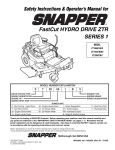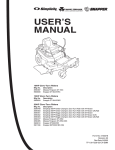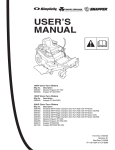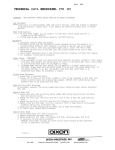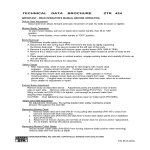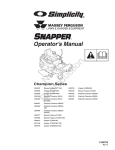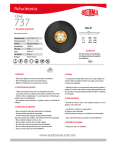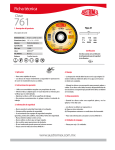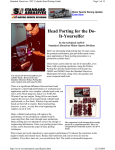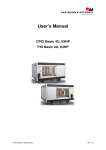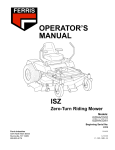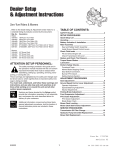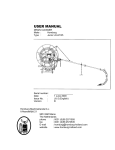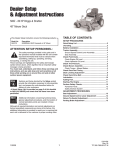Download Simplicity Manufacturing 5900608 ZT18441KHC User's Manual
Transcript
Dealer Setup & Adjustment Instructions FastCut Hydro Drive Zero-Turn Riders & Mowers TABLE OF CONTENTS: This Dealer Setup Instruction covers the following products: Mfg. No. 5900608 5900609 5900610 SAFETY RULES .................................................................2 Description ZT18441KHC, 18HP Zero-Turn Rider with 44” Mower ZT19441KWV, 19HP Zero-Turn Rider with 44” Mower ZT20501BV, 20HP Zero-Turn Rider with 50” Mower SETUP PROCEDURES Quick Setup List ................................................................3 Uncrating ............................................................................4 Battery Activation & Installation ......................................4 Rider Assembly .................................................................5 Seat and Safety Switch Assembly ...................................5 Install Ground Speed Control Levers ...............................5 Check Fluid levels .............................................................5 Fill and Check Engine Oil.................................................6 Check Transmission Oil Level .........................................6 Reduce and Check Tire Pressure ....................................6 Torque Mower Blades .......................................................7 Lubrication .........................................................................7 Perform Safety Checks .....................................................8 Functional Tests...............................................................8 Mower Blade Stopping Check..........................................8 Seat Switch Connection ...................................................8 Burnish PTO Clutch .........................................................8 Safety Interlock System ...................................................9 ATTENTION SETUP PERSONNEL: The safety warnings provided in this guide and in the operator's manual included with the unit contain important information that must be obeyed when assembling, setting-up, operating, servicing, transporting, or storing the unit. These warnings are highlighted by the safety alert triangle symbol shown above, which signifies that an important safety message is being provided. You must read, understand, and follow these warnings and instructions, and use safe shop and work practices at all times while working on or around this unit and all other outdoor power equipment. Sections and items denoted by the Setup symbol provide the information necessary to fully assemble, test, and prepare the units described above for delivery to your customers. ADJUSTMENT PROCEDURES Seat Adjustments ..............................................................9 Ground Speed Control Lever Adjustment.....................10 Operator Adjustment ......................................................10 Speed Balancing Adjustment .........................................10 Return-To-Neutral & Neutral Adjustment .......................11 Parking Brake Adjustment..............................................12 PTO Clutch Adjustment ..................................................13 PTO Clutch Adjustment .................................................13 Blade Brake Check ........................................................13 Mower Deck Leveling ......................................................14 Additional information concerning functional tests, general adjustment procedures, and the location of normal lubrication points are included in these instructions. SERVICE PROCEDURES Transmission Oil Filter Change .....................................15 Hydraulic Pump Drive Belt Replacement ......................16 Mower Belt Replacement ................................................17 Form No. 5100277 Revision IR 7/2005 1 TP 300-7237-IR-HZ-N FastCut Hydro Drive ZTR SAFETY RULES Read these safety rules and follow them closely. Failure to obey these rules could result in loss of control of equipment, severe personal injury or death to you, yourself or bystanders, or damage to property or equipment. This mowing deck is capable of amputating hands and feet and throwing objects. The triangle in text signifies important cautions or warnings which must be followed. • Keep all movement on the slopes slow and gradual. Do not make sudden changes in speed or direction. • Avoid starting or stopping on a slope. If tires lose traction, disengage the blade(s) and proceed slowly straight down the slope. DO NOT • Do not turn on slopes unless necessary, and then, turn slowly and gradually downhill, if possible. • Do not mow near drop-offs, ditches, or embankments. The unit could suddenly turn over if a wheel is over the edge of a cliff or ditch, or if an edge caves in. • Do not mow on wet grass. Reduced traction could cause sliding. • Do not try to stabilize the unit by putting your foot on the ground. • Do not use grass catcher on steep slopes. III. Children Tragic accidents can occur if the operator is not alert to the presence of children. Children are often attracted to the unit and the mowing activity. Never assume that children will remain where you last saw them. 1. Keep children out of the mowing area and under the watchful care of another responsible adult. 2. Be alert and turn unit off if children enter the area. 3. Before and when backing, look behind and down for small children. 4. Never carry children. They may fall off and be seriously injured or interfere with safe unit operation. 5. Never allow children to operate the unit. 6. Use extra care when approaching blind corners, shrubs, trees, or other objects that may obscure vision. IV. Service 1. Use extra care in handling gasoline and other fuels. They are flammable and vapors are explosive. a) Use only an approved container. b) Never remove gas cap or add fuel with the engine running. Allow engine to cool before refueling. Do not smoke. c) Never refuel the unit indoors. d) Never store the unit or fuel container inside where there is an open flame, such as a water heater. d) Clean up oil and fuel spills immediately. 2. Never run a unit inside a closed area. 3. Keep nuts and bolts, especially blade attachment bolts, tight and keep equipment in good condition. 4. Never tamper with safety devices. Check their proper operation regularly. 5. Keep equipment free of grass, leaves, or other debris build-up. 6. Stop and inspect the equipment if you strike an object. Repair, if necessary, before restarting. 7. Never make adjustments or repairs with the engine running. 8. Grass catcher components are subject to wear, damage, and deterioration, which could expose moving parts or allow objects to be thrown. Frequently check components and replace, when necessary, with manufacturer’s recommended parts. 9. Mower blades are sharp and can cut. Wrap the blade(s) or wear gloves, and use extra caution when servicing them. 10. Check brake operation frequently. Adjust and service as required. 11. Allow the unit to cool before storing. IMPORTANT – Safe operation practices for riding mowers. I. General operation 1. Read, understand, and follow all instructions in the manual and on the unit before starting. 2. Only allow responsible adults, who are familiar with the instructions, to operate the unit. 3. Clear the area of objects such as rocks, toys, wire, etc., which could be picked up and thrown by the blade(s). 4. Be sure the area is clear of other people before mowing. Stop the unit if anyone enters the area. 5. Never carry passengers. 6. Do not mow in reverse unless absolutely necessary. Always look down and behind before and while backing. 7. Be aware of the mower discharge direction and do not point it at anyone. Do not operate the mower without either the entire grass catcher or the guard in place. 8. Slow down before turning. 9. Never leave a running unit unattended. Always turn off blades, set parking brake, stop engine, and remove keys before dismounting. 10. Turn off blades when not mowing. 11. Stop engine before removing grass catcher or unclogging chute. 12. Mow only in daylight or good artificial light. 13. Do not operate the unit while under the influence of alcohol or drugs. 14. Watch for traffic when operating near or crossing roadways. 15. Use extra care when loading or unloading the unit into a trailer or truck. II. Slope operation Slopes are a major factor related to loss-of-control and tip-over accidents, which can result in severe injury or death. All slopes require extra caution. If you cannot back up the slope or if you feel uneasy on it, do not mow it. WARNING – SLOPE OPERATION Never operate on slopes greater than 17.6 percent (10°) which is a rise of 3-1/2 feet (106 cm) vertically in 20 feet (607 cm) horizontally. Select slow ground speed before driving onto slope. In addition to front and rear weights, use extra caution when operating on slopes with rear-mounted grass catcher. Mow UP and DOWN the slope, never across the face, use caution when changing directions and DO NOT START OR STOP ON SLOPE. DO • See your authorized dealer for recommendations of wheel weights or counterweights to improve stability. • Mow up and down slopes, not across. • Remove obstacles such as rocks, tree limbs, etc. • Watch for holes, ruts, or bumps. Uneven terrain could overturn the unit. Tall grass can hide obstacles. • Use slow ground speed so that you will not have to stop or change speeds while on the slope. • Use extra care with grass catchers or other attachments. These can change the stability of the unit. TP 300-7237-IR-HZ-N 2 7/2005 FastCut Hydro Drive ZTR Quick Setup List Page Setup Procedure Steps to Perform 4 Uncrating ❏ Remove crate & banding. ❏ Place transmissions in PUSH position & roll off skid. 4 Battery Activation & Installation ❏ Charge the battery (Note: proceed with other setup steps while battery is charging). ❏ Test battery with hydrometer or load-tester. ❏ Install & secure battery. 5 Rider Assembly ❏ Install the seat and connect the seat switch ❏ Install ground speed control levers. 6 Check Fluid Levels ❏ Fill & check Engine oil level. ❏ Check transmission fluid level. ❏ Reduce & check tire pressures (Front tires 40 psi, rear tires 15 psi). 7 Mower Assembly ❏ Torque mower blade bolts. 7 Lubrication ❏ Lubricate all grease & oil points. 8 SAFETY CHECKS ❏ ❏ ❏ ❏ Check for LOOSE HARDWARE. Check all OPERATOR CONTROLS. Test PARKING BRAKE. Perform MOWER BLADE STOPPING CHECK. (Blade must stop within 5 seconds!) ❏ Perform SAFETY INTERLOCK SYSTEM CHECK. 8 Burnish Electric Clutch ❏ Burnish electric clutch (run for 15 seconds, repeat 10 times). ❏ Repeat MOWER BLADE STOPPING CHECK. (Blade must stop within 5 seconds!) 7/2005 3 TP 300-7237-IR-HZ-N FastCut Hydro Drive ZTR Uncrating 1. Using a reciprocating utility saw or equivalent, cut crate away from bottom skid. Remove crate. Remove shrink-wrap plastic. 2. Cut any banding securing the unit. 3. Release parking brake. A IMPORTANT NOTE When cutting crate from bottom skid, use caution around tires and mower rollers. Figure 1. Transmission Release Valves A. Hydraulic Release Valve (On Each Pump) 4. Place hydro release valves (A, Figure 1) in the PUSH position by turning the valve counterclockwise one to two turns. 5. Be sure there are no nails or sharp objects on the bottom of the skid to puncture the tires. Roll the rider forward off the skid. B C 6. Engage the hydro pumps by tightening the release valves (A) to 80-120 in. lbs. A Battery Activation & Installation WARNING BATTERY SAFETY RULES • Battery acid causes severe burns. Avoid contact with skin. • Wear eye protection while handling the battery. • To avoid an explosion, keep flames and sparks away from battery, especially while charging. • When installing battery cables, CONNECT THE POSITIVE (+) CABLE FIRST and negative (-) cable last. If not done in this order, the positive terminal can be shorted to the frame by a tool. Figure 2. Battery A. Negative Cable B. Positive Cable & Cover C. Rubber Hold-Down Strap Charge Battery Install Battery 1. Tip the seat forward to access the battery. 1. Install the battery in the battery compartment and secure using the rubber hold-down strap (C, Figure 2). 2. To charge the battery, follow the instructions provided by the battery charger manufacturer as well as all warnings included in the safety rules section of this document. Charge the battery until fully charged (until the specific gravity of the electrolyte is 1.250 or higher and the electrolyte temperature is at least 60° F). Do not charge at a rate higher than 10 amps. TP 300-7237-IR-HZ-N 2. Connect the red positive battery cable (B) to the positive battery post. 3. Connect the black negative battery cable (A) to the negative battery post using a capscrew, washer, lockwasher and nut. 4 7/2005 FastCut Hydro Drive ZTR Rider Assembly B A C Seat & Safety Switch Assembly 1. Mount the seat (A, Figure 3) to the seat plate (B) using four 5/16-18 nylock flange nuts (C) and tighten securely. 2. Connect the seat switch wire harness (D) to the seat switch. D C Figure 3. Seat Installation A. Seat B. Seat Plate C. 5/16-18 Nylock Flange Nut (4) D. Seat Switch Wire Harness Install Ground Speed Control Levers 1. Mount the control levers (F, Figure 4) to the control lever base (E) using four 5/16-18 x 1” bolts, lockwashers, and washers. D FRONT NOTE: The ground speed control levers and seat must be adjusted to fit the operator. See SEAT ADJUSTMENTS and GROUND SPEED CONTROL LEVER ADJUSTMENTS in the Adjustments section. A B C E Figure 4. Install Control Levers A. 5/16-18 x 1” Bolts B. 5/16 Lockwashers C. 5/16 Washers D. Control Lever E. Control Lever Base 7/2005 5 TP 300-7237-IR-HZ-N FastCut Hydro Drive ZTR B A A B D E C Figure 5. Check Fluid Levels A. Fuel Tank Cap B. Transmission Oil Cap C. Engine Oil Dip Stick D. Locking Tab E. Locking Screw Figure 6. Transmission Oil Fill Level A. Fill Level Mark Check Fluid Levels Fill & Check Engine Oil 1. Use the dipstick (C, Figure 5) to check the engine oil level. If necessary add engine oil. Check engine manufacturer’s owner’s manual for oil recommendations. Check /Fill Transmission Oil Oil Type: Mobil 1™, 15W-50 synthetic oil or Castrol Syntec™ 5W-50 oil. Tire Pressure Front 40 psi (2,76 bar) Rear 15 psi (1,03 bar) Figure 7. Tire Pressures 1. Check the oil level when the unit is cold. The inspection port is located on the inside of the right tank cover. The oil level should be within 1/2” (1.3 cm) of the horizontal level mark (A, Figure 6). If the oil is below this level, proceed to step 2. Reduce & Check Tire Pressures The tires are over-inflated for shipping purposes. Inflate to the pressures shown. Note that these pressures may differ slightly from the “Max Inflation” stamped on the side-wall of the tires. The pressures shown provide proper traction, improve cut quality, and extend tire life. 2. Before removing the reservoir cap, make sure the area around the reservoir cap and fill neck of the reservoir is free of dust, dirt, or other debris. Loosen the locking capscrew (E, Figure 5) securing the locking tab (D), slide the lock tab back, and remove the cap (B). 3. Add either Mobil 1™, 15W-50 synthetic oil or Castrol Syntec™ 5W-50 oil. DO NOT use conventional oils. 4. Reinstall the reservoir cap, move the locking tab between two notches, and tighten the locking capscrew. The locking tab is installed as a reminder to the customer to not put fuel in this reservoir. TP 300-7237-IR-HZ-N 6 7/2005 FastCut Hydro Drive ZTR B C Torque Mower Blades WARNING For your personal safety, blade mounting capscrews must each be installed with a hex washer and spring washer, then securely tightened. Torque blade mounting capscrew to 45 - 55 ft. lbs. (61 - 75 N.m.) D A 1. Check that blades are installed with the tabs pointing up toward deck as shown in Figure 8. Secure with a capscrew, spring washer and spline/hex washer (be certain the spline/hex washer is aligned with the shaft). Use a wooden block to prevent blade rotation and torque capscrews to 45-55 ft.lbs. (61-75 N.m.). Figure 8. Blade Installation A. 4x4 Wood Block B. Hex Washer C. Spring Washer D. Blade Capscrew Lubrication Lubricate the unit at the following lubrication points shown in Figure 9. Grease: Oil: • front caster wheel axles • front caster yokes • mower deck idler arm • mower deck arbors • control handle pivots • discharge chute hinge Generally, all moving metal parts should be oiled where contact is made with other parts. Keep oil and grease off belts and pulleys. Remember to wipe fittings and surfaces clean both before and after lubrication. Use grease fittings when present. Disassemble parts to apply grease to moving parts when grease fittings are not installed. Not all greases are compatible. Use automotive-type lithium grease. Lube Idler Arm Pivot Figure 9. Lubrication 7/2005 7 TP 300-7237-IR-HZ-N FastCut Hydro Drive ZTR Perform Safety Checks Burnish PTO Clutch 1. Select a safe area to operate the mower deck. With the drive in neutral, the PTO switch disengaged, and an operator in the seat, start the tractor engine. Run the engine at full throttle. WARNING Disengage the PTO, stop the engine, set the parking brake, and wait for moving parts to stop before leaving operator's position for any reason. 2. Engage the PTO switch and run the deck for fifteen seconds. Disengage the PTO switch and wait for the mower drive belt to stop. If the unit does not pass the test, do not operate it. Under no circumstance should you attempt to defeat the purpose of the safety system. 3. Repeat step 2 above ten times, and then re-check the mower blade stopping time. (Stopping time must be five seconds or less.) Functional Tests 1. Check for loose bolts, screws, nuts, etc. 2. Start the engine and check all controls for proper operation: ground speed control levers, parking brake lever, throttle and choke cables, electric PTO clutch, attachment lift, etc. 3. Stop the engine and check for fluid leaks: oil, gasoline, or transmission oil. 4. If any control fails to operate properly during testing or seems to be out of adjustment, check and readjust it according to the following Adjustments section. 4. Turn the key to OFF to end the demonstration. Mower Blade Stopping Check Mower blades and mower drive belt should come to a complete stop within five seconds after the electric clutch switch is turned off. With the tractor in neutral, the electric clutch switch disengaged, and an operator in the seat, start the tractor engine. Run the engine at full throttle. Engage the electric PTO clutch switch and wait several seconds. Disengage electric clutch switch and check the time it takes for the mower drive belt to stop. If the mower drive belt does not stop within five seconds, adjust the PTO clutch according to the instructions in the Electric Clutch Adjustment section. Seat Switch Connection Check that the seat switch wire harness (D, Figure 2) is connected to the seat switch. TP 300-7237-IR-HZ-N 8 7/2005 FastCut Hydro Drive ZTR Adjustment Procedures SAFETY INTERLOCK SYSTEM This unit is equipped with safety interlock switches. These safety systems are present for your safety, do not attempt to bypass safety switches, and never tamper with safety devices. Check their operation regularly. Seat Adjustments The seat and ground speed control levers should be adjusted so that operator’s elbows are supported by the arm rests when his/her hands are on the controls, and the ground speed control levers can be moved through their full range of motion without contacting the operator’s legs. Operational SAFETY Checks TEST 1 — ENGINE SHOULD NOT CRANK IF: • PTO switch is engaged, OR Seat Position Adjustment • Parking brake is not engaged, OR The seat can be adjusted forward and back. Move the adjustment lever (A, Figure 10) towards the left hand side of the machine, slide the seat to the desired position, and release the lever. • Motion control handles are not in their NEUTRAL positions. TEST 2 — ENGINE SHOULD CRANK IF: • PTO switch is NOT engaged, AND • Parking brake is engaged, AND • Motion control handles are locked in their NEUTRAL positions. TEST 3 — ENGINE SHOULD SHUT OFF IF: • Operator rises off seat with PTO engaged, OR • Operator rises off seat with parking brake disengaged, OR • Operator moves motion control handles out of their neutral positions before disengaging parking brake. TEST 4 — BLADE BRAKE CHECK The mower blades and mower drive belt should come to a complete stop within five seconds after the electric PTO switch is turned off (or operator rises off seat). If mower drive belt does not stop within five seconds, see your dealer. A Figure 10. Seat Adjustment A. Adjustment Lever NOTE: Once the engine has stopped, the PTO switch must be turned off, parking brake must be engaged, and the ground speed control handles must be locked in their NEUTRAL positions in order to start the engine. WARNING If the unit does not pass a safety test, do not operate it. Under no circumstance should you attempt to defeat the purpose of the safety interlock system. 7/2005 9 TP 300-7237-IR-HZ-N FastCut Hydro Drive ZTR Ground Speed Control Lever Adjustment C Operator Adjustment The control levers can be adjusted in three ways. The alignment of the control levers, the placement of the levers (how close the ends are to one another) and the height of the levers can be adjusted. To Adjust the Handle Alignment: Loosen the mount bolts (A, Figure 11) and pivot the lever(s) (C) to align with each other. To Adjust the Handle Placement: Loosen the jam nuts and adjust the placement bolt (B, Figure 11) in or out to properly adjust the lever end spacing. A B Figure 11. Control Lever Adjustment A. Alignment Hardware B. Placement Hardware C. Ground Speed Control Lever To Adjust the Handle Height: Remove the mounting hardware and reposition the handle either up or down from its original position. You will need to readjust the handle alignment as described above. Speed Balancing Adjustment C If the rider veers to the right or left when the ground speed control levers are in the maximum forward or reverse position, the top speed of each of these levers can be balanced by turning the adjustment bolt(s) (A, Figure 12). Only adjust the speed of the wheel that is traveling faster. A TO REDUCE THE SPEED OF THE FASTER WHEEL 1. Loosen the securing nut. B 2. Turn the top speed adjustment bolt COUNTERCLOCKWISE to reduce the speed. 3. Retighten the securing nut when adjustment is complete. Figure 12. Top Speed Adjustment A. Forward Top Speed Adjustment Bolt B. Control Lever Base C. Reverse Top Speed Adjustment Bolt WARNING DO NOT adjust the rider for a faster overall speed forward or reverse than it was designed for. TP 300-7237-IR-HZ-N 10 7/2005 FastCut Hydro Drive ZTR Return-To-Neutral & Neutral Adjustment RETURN-TO-NEUTRAL ADJUSTMENT To determine if it is necessary to adjust the neutral return, perform the following steps. A B C 1. Disengage the PTO, engage the parking brake and turn off the engine. 2. Move the ground speed control levers into the operating position, pull levers rearward and release. 3. Move the ground speed control levers out towards the neutral position. If the levers do not align with the notches in the neutral lock plate, it is necessary to adjust the neutral return rod (C, Figure 13). TO ADJUST: 1. Loosen the jam nut (B) locked against the clevis (A). 2. Turn the neutral return rod (C) to adjust handle position. 4. Pull lever rearward and release to check position again. Adjust as necessary to align levers with notches. It is important to note that after every adjustment of the neutral return rod, the lever must be pulled rearward and released to properly check the neutral position. Figure 13. Return-To-Neutral Adjustment A. Clevis B. Jam Nut C. Neutral Return Rod 5. Once the lever alignment has been adjusted, lock jam nut against the clevis. NEUTRAL ADJUSTMENT B If the tractor creeps while the ground speed control levers are locked in neutral, then it may be necessary to adjust the linkage rods. Perform this adjustment on a hard level surface such as a concrete floor. IMPORTANT NOTE: This adjustment should be performed with the engine OFF. Perform the adjustment, then start the engine to check the adjustment. If further adjustment is required, stop the engine before adjusting the linkage. A 1. Determine which wheel is creeping. The left side hydro pump and control linkage control the left wheel, the right linkage controls the right wheel. 2. Disengage the PTO, engage the parking brake, turn the engine off, remove the key, and wait for all moving parts to stop. Figure 14. Neutral Adjustment A. Control Rod Spring B. Rod End 3. Check the control rod spring (A, Figure 14) length. The compressed spring length should be 2-3/16” (5,56cm) 5. Start the unit and check for transmission creep. Repeat steps 2-4 if necessary. 4. Disconnect the rod end (B) and loosen the jam nut. Turn the rod end one to two turns to lengthen or shorten the control rod, then retighten the jam nut, and reconnect the rod end. 7/2005 11 TP 300-7237-IR-HZ-N FastCut Hydro Drive ZTR Parking Brake Adjustment B 3/16" (5 mm) 1. Disengage the PTO, stop the engine, block the front wheels, remove the ignition key, and engage the parking brake. For easier access to the brake adjustment linkage, the rear wheels may be removed. 2" (5 cm) 2. Check the brake spring (A, Figure 15) length (both wheels). With the brake engaged the compressed spring length should be 2” (5 cm). If not, adjust the locknut (C) to achieve the compressed spring length of 2” (5 cm). 3. After achieving the correct spring compression, check the set collar gap (B). With the parking brake engaged, the set collar gap should be 3/16" (5 mm). If not, loosen the set collar screw and move the collar to the correct position. TP 300-7237-IR-HZ-N A C Figure 15. Parking Brake Adjustment A. Brake Spring B. Set Collar C. Locknut 12 7/2005 FastCut Hydro Drive ZTR A B B B C B Figure 17. Adjust PTO Clutch A. Window B. Adjustment Nut C. .016”-.018” (0,40-0,45mm) Feeler Gauge A Figure 16. PTO Clutch Adjustment A. Adjustment Window (Qty. 3, one shown) B. Adjustment Nut PTO Clutch Adjustment WARNING To avoid serious injury, perform adjustments only with engine stopped, key removed and rider on level ground. Check the PTO clutch adjustment after the initial 25 hour break-in period and then after every 250 hours of operation. Also perform the following procedure if the clutch is slipping or will not engage, or if a new clutch has been installed. Blade Brake Check 1. Remove key from ignition switch and disconnect spark plug wires to prevent the possibility of accidental starting while the PTO is being adjusted. Mower blades and mower drive belt should come to a complete stop within five seconds after electric PTO switch is turned off. 2. See Figure 16. Note the position of the 3 adjustment windows (A) in the side of the brake plate and the nylock adjustment nuts (B). 1. With parking brake engaged, PTO disengaged and an operator in the seat, start the engine. 3. Insert a .016”-.018” (0,40-0,45mm) feeler gauge (C) through each window, positioning the gauge between the rotor face and the armature face as shown in Figure 17. 2. Have an assistant observe the mower drive belt through the opening between the frame and top of mower deck. Engage the PTO and wait several seconds. Disengage the PTO and check the amount of time it takes for the mower drive belt to stop. 4. Alternately tighten the adjustment nuts (B, Figure 16) until the rotor face and armature face just contacts the gauge. 3. If the mower drive belt does not stop within five seconds, perform the PTO Clutch Adjustment. If the belt still does not stop within 5 seconds, replace the clutch. 5. Check the windows for an equal amount of tension when the gauge is inserted and removed, and make any necessary adjustments by tightening or loosening the adjustment nuts. NOTE: The actual air gap between the rotor and armature may vary even after performing the adjustment procedure. This is due to dimensional variations on component parts, and is an acceptable condition. 6. Check the mower blade stopping time. The mower blades and mower drive belt should come to a complete stop within five seconds after the electric PTO switch is turned off. 7/2005 13 TP 300-7237-IR-HZ-N FastCut Hydro Drive ZTR Mower Deck Leveling Perform these adjustments on a flat level surface. SIDE-TO-SIDE LEVELING 1. With the mower installed, place the rider on a smooth, level surface such as a concrete floor. Turn the front wheels so they are straight. 2. Check for bent blades and replace if necessary. Figure 18. Orient Blades Side-to-Side 3. Place the mower cutting height pin in the 4th hole from the bottom (see insert, Figure 20). Arrange the outside mower blades so that they are pointing from side-to-side (Figure 18). A B 4. Measure the distance between the outside tips of each blade and the ground (Figures 18 & 19). If there is more than 1/8” (3mm) difference between the measurements on each side, proceed to step 5. If the difference is 1/8” (3mm) or less, proceed to step 6. 5. Use the rear leveling links (B, Figure 20) to adjust the side-to-side leveling of the deck. Repeat step 4 if necessary. C Figure 19. Measure Blade Tips to Ground A. Mower Deck C. Level Ground B. Blade Tip FRONT-TO-BACK LEVELING 6. Arrange the blades so they face front-to-back (Figure 21). B C 7. Measure the distance from the ground to the front tip of the center blade, and from the ground to rear tips of left-hand and right-hand blades (Figures 19 & 21). The front tip of the center blade should be 1/4" (6mm) higher than rear tips of left-hand and right-hand blades. If not, proceed with steps 8 - 11. 8. Check the length of the hanging rods. The rear (D, Figure 20) should be 15” (38,1cm) and is not adjusted. To adjust the pitch of the mower deck, adjust the front leveling nuts only. A 9. Loosen the front lock nuts (E, Figure 20). E 10. Turn the leveling nuts (A, Figure 20) counterclockwise to lower the front of mower deck. Turn the nuts clockwise to raise the front of the mower. Make adjustments in small increments, trying to keep tension on both leveling nuts. 11. Tighten the front lock nuts (E). D Figure 20. Mower Leveling A. Front Leveling Nuts B. Rear Leveling Rods C. 4th Cutting Height Hole D. Rear Hanger Rods E. Front Lock Nuts 12. Re-check the blade measurement then repeat steps 7-11 as necessary. Figure 21. Orient Blades Front-to-Back TP 300-7237-IR-HZ-N 14 7/2005 FastCut Hydro Drive ZTR Service Procedures B A Transmission Oil Filter Change B D Do not allow dirt, water, or other debris to enter the expansion chamber or transmission. Even a small amount of dirt can damage the transmission E C Change Interval: Every 250 Hours Filter Part Number: 1719168 1. Locate the transmission oil filter (C, Figure 24) at the rear of the battery compartment under the seat. Figure 23. Maintenance A. Fuel Tank Cap B. Transmission Oil Cap C. Fuel Filter D. Locking Tab E. Locking Screw 2. Lubricate the new filter base with a few drops of transmission oil. Fill the filter half full of oil. 3. Clean the area around the filter base and remove the filter. Do NOT drain the hydraulic system oil. 4. Thread the new filter onto the filter base until the gasket makes contact, then tighten 3/4 of a turn more. B NOTE: The oil will drain from the reservoir tank if the new filter is not quickly reinstalled. 5. Run the unit for several minutes and check the transmission oil level (D). IMPORTANT NOTE: Use caution after changing the filter; air in the hydraulic system may affect the responsiveness of the control levers. Repeat step 5 until the air is out of the system. A D C Figure 24. Battery Compartment A. Positive (+) Cable & Terminal B. Negative (-) Cable & Terminal C. Transmission Filter D. Transmission Fill Level Mark 7/2005 15 TP 300-7237-IR-HZ-N FastCut Hydro Drive ZTR Hydraulic Pump Drive Belt Replacement B To avoid damaging belts, DO NOT PRY BELTS OVER PULLEYS. 1. Park the rider on a smooth, level surface such as a concrete floor. Disengage the PTO, engage the parking brake, turn off the engine, and remove the ignition key. G F 2. Remove the PTO drive belt (see MOWER BELT REPLACEMENT for removal instructions). 3. Loosen the nut towards the front of the machine on the spring anchor hook (H, Figure 25) to release the majority of the belt tension. Use caution and remove the nut to completely release the tension. 4. Remove the old belt and replace it with the new one. Make sure the V-side of the belt runs in the grooves of the crankshaft pulley and pump pulleys (B & C). 5. Reinstall the anchor hook (H) into the anchor tab and loosely fasten the nut. Adjust the spring until a measurement of 7-3/4” (19,7cm) is achieved from the outside of the spring hooks. Tighten nut. 6. Reinstall the PTO drive belt. TP 300-7237-IR-HZ-N H E D C C A Figure 25. Hydraulic Pump Drive Belt Replacement (Shown from Below) A. Pump Drive Belt B. Crankshaft Pulley C. Pump Pulley D. Idler Pulley (stationary) E. Idler Pulley F. Idler Arm G. Spring H. Spring Anchor Hook 16 7/2005 FastCut Hydro Drive ZTR Mower Belt Replacement To avoid damaging belts, DO NOT PRY BELTS OVER PULLEYS. A C 1. Park the rider on a smooth, level surface such as a concrete floor. Disengage the PTO, engage the parking brake, turn off the engine, and remove the ignition key. B A A D 2. Raise the mower deck to transport position. Pull the lever (A, Figure 27) towards the rear of the machine to release tension on the mower belt. Secure the lever in the guard notch (B). Figure 26. Mower Belt Routing A. Arbor Pulleys B. Back-Side Idler Pulleys C. PTO Pulley D. Belt Tension Release Lever 3. Remove the old drive belt and install the new one as shown in Figure 26. Note that the back of the drive belt must ride against the back-side idler pulleys (B). Use the belt tension lever (A, Figure 27) to release tension on the idler pulley for installation. B A Figure 27. Release Belt Tension A. Belt Tension Release Lever B. Guard Notch 7/2005 17 TP 300-7237-IR-HZ-N FastCut Hydro Drive ZTR Notes TP 300-7237-IR-HZ-N 18 7/2005 FastCut Hydro Drive ZTR Notes 7/2005 19 TP 300-7237-IR-HZ-N PRODUCTS, INC. McDonough, GA., 30253 www.snapper.com © 2003 Simplicity Manufacturing, Inc. All Rights Reserved




















